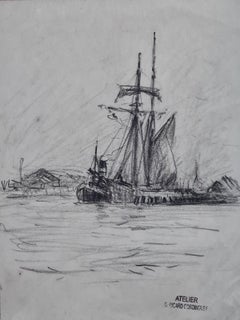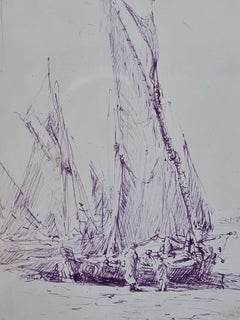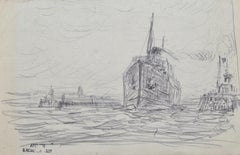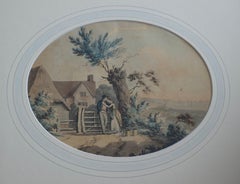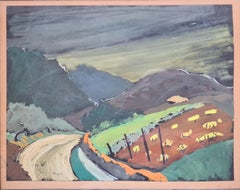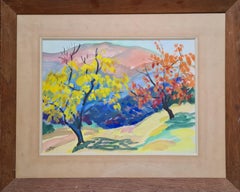Georges Ricard-Cordingley Art
to
3
2
1
2
1
3
Overall Height
to
Overall Width
to
3
3
1
3
13
12
9
3
2
3
2
1
1
Artist: Georges Ricard-Cordingley
Dealer: La Galerie Cotignac
Sail vs Steam, 19th Century French Marine Drawing
By Georges Ricard-Cordingley
Located in Cotignac, FR
Late 19th century drawing on paper of a French marine scene by noted French artist Georges Ricard-Cordingley. Carrying the atelier stamp to the bottom right, presented in modern black frame.
Provenance: This drawing came from the estate of the artist's daughter who had acquired it directly from her father. It is from his earliest period of drawing when his talents were first being recognised.
A charming drawing capturing the scene of a steam tug docked next to a larger sailing boat, the scene probably at Boulogne sur Mer. Cordingley has captured the majesty of the scene, the juxtaposition of old and new technologies. It probably dates from his earliest period when he was showing prodigious talent in his early teens.
Georges Ricard was born on January 30, 1873 in Lyon, son of Prosper Louis Ricard and Georgina Marie Cordingley. He spent part of his childhood in Lyon and Boulogne-sur-Mer. He displayed early gifts for drawing. He lost his father in 1885.
He began his training around 1887, becoming a pupil of Jean-Charles Cazin, a landscape painter from Pas-de-Calais and the Côte d'Opale. He then joined the School of Fine Arts in Lyon and remained there from 1888 to 1889. He moved to Paris in 1890, where he studied at the Académie Julian as a pupil of Benjamin Constant, Louis Martinet and Jules Lefebvre.
He lost his mother around 1892, went to England to his maternal family and added his mother's name to his name. He embarked for the North Sea with the Royal National Mission to Deep Sea Fishermen and carried out his first studies. In 1894, he met with great success at the court of Queen Victoria. He embarked a second time, in 1895, still for the North Sea and produced numerous studies of waves of clouds, of the port and of portraits of fishermen...
Category
Late 19th Century Romantic Georges Ricard-Cordingley Art
Materials
Paper, Charcoal, Pencil
Fishing Boats, late 19th Century French Marine Mauve Ink Drawing
By Georges Ricard-Cordingley
Located in Cotignac, FR
Late 19th century mauve ink drawing on paper of fishing boats at harbour by noted French artist Georges Ricard-Cordingley. The drawing is signed bottom left and carries various annotations and another small sketch. The drawing is presented in a period wood frame under glass with a double card mount.
Provenance: This drawing came from the estate of the artist's daughter who had acquired it directly from her father.
A charming drawing capturing the scene fishing boats at harbour with extensive detail of the rigging and sails. It seems to be a preparatory sketch as it carries extensive colour and other annotations. There is also a smaller sketch bottom right which shows the boat from a different perspective. The figures are well annotated and Cordingley has achieved great detail but with a lightness of touch.
The sketch is even more interesting as it is completed in mauve ink. This was a fashionable and technical innovation at the time as the colour was only 'invented' in the late 1850s. A really interesting, lovely and evocative drawing.
Georges Ricard was born on January 30, 1873 in Lyon, son of Prosper Louis Ricard and Georgina Marie Cordingley. He spent part of his childhood in Lyon and Boulogne-sur-Mer. He displayed early gifts for drawing. He lost his father in 1885.
He began his training around 1887, becoming a pupil of Jean-Charles Cazin, a landscape painter from Pas-de-Calais and the Côte d'Opale. He then joined the School of Fine Arts in Lyon and remained there from 1888 to 1889. He moved to Paris in 1890, where he studied at the Académie Julian as a pupil of Benjamin Constant, Louis Martinet and Jules Lefebvre.
He lost his mother around 1892, went to England to his maternal family and added his mother's name to his name. He embarked for the North Sea with the Royal National Mission to Deep Sea Fishermen and carried out his first studies. In 1894, he met with great success at the court of Queen Victoria. He embarked a second time, in 1895, still for the North Sea and produced numerous studies of waves of clouds, of the port and of portraits of fishermen which he exhibited in Paris and London. He embarked a third time, around 1896, in the North Sea and the Atlantic Ocean with the Société des Travaux de Mer and was shipwrecked in Newfoundland.
In 1901, he set up his studio in Boulogne-sur-Mer. He divided his time between London, Paris and Boulogne-sur-Mer and painted portraits and seascapes. He realized the decoration of the casino of Wimereux.
He travelled to Australia, where he exhibited from 1909 to 1910.
In 1911, he married Suzanne Giraud-Teulon, the daughter of historian Alexis Giraud-Teulon, and had three children, Éliane, Louis and Gabrielle.
During the First World War, he was assigned to Lyon as a stretcher...
Category
Late 19th Century Romantic Georges Ricard-Cordingley Art
Materials
Paper, Ink
Paquebot à Boulogne Sur Mer, late 19th Century French Marine Drawing
By Georges Ricard-Cordingley
Located in Cotignac, FR
Late 19th century drawing on paper of a French marine scene by noted French artist Georges Ricard-Cordingley. Carrying the atelier stamp to the bottom left and with full annotation and certification to the back of the paper.
Provenance: This drawing came from the estate of the artist's daughter who had acquired it directly from her father. It is from his earliest period of drawing when his talents were first being recognised.
A charming drawing capturing the scene of a paquebot, a small passenger ship, leaving the dock at Boulogne sur Mer. Cordingley has captured the majesty of the scene, the rolling waves, the force of nature.
Georges Ricard was born on January 30, 1873 in Lyon, son of Prosper Louis Ricard and Georgina Marie Cordingley. He spent part of his childhood in Lyon and Boulogne-sur-Mer. He displayed early gifts for drawing. He lost his father in 1885.
He began his training around 1887, becoming a pupil of Jean-Charles Cazin, a landscape painter from Pas-de-Calais and the Côte d'Opale. He then joined the School of Fine Arts in Lyon and remained there from 1888 to 1889. He moved to Paris in 1890, where he studied at the Académie Julian as a pupil of Benjamin Constant, Louis Martinet and Jules Lefebvre.
He lost his mother around 1892, went to England to his maternal family and added his mother's name to his name. He embarked for the North Sea with the Royal National Mission to Deep Sea Fishermen and carried out his first studies. In 1894, he met with great success at the court of Queen Victoria. He embarked a second time, in 1895, still for the North Sea and produced numerous studies of waves of clouds, of the port and of portraits of fishermen...
Category
Late 19th Century Realist Georges Ricard-Cordingley Art
Materials
Paper, Pencil
Related Items
Paul Schürch (1886-1939) - Romantic Landscape Drawing 1917 Solothurn Switzerland
Located in Meinisberg, CH
Paul Schürch
(Swiss, ∗ 14.2.1886 Wangen b. Olten, † 11.12.1939 Bern)
Romantic Landscape in area of Solothurn, Switzerland
• Charcoal/Pencil drawing delicately heightened in various...
Category
1910s Naturalistic Georges Ricard-Cordingley Art
Materials
Laid Paper, Pencil, Pastel, Charcoal
Free Shipping
H 11.42 in W 17.92 in D 0.16 in
English School, circa 1800 Georgian watercolor, The Sailor's return
Located in Harkstead, GB
A delightful rustic scene dating to circa 1800 with the sailor returning to his thankful wife and the domestic idyll of his country cottage. The harbour with sailing ships ferrying c...
Category
Early 19th Century Romantic Georges Ricard-Cordingley Art
Materials
Laid Paper, Watercolor
H 6.5 in W 8.5 in D 1 in
The Family - Original Drawing by George-Henri Tribout - 1940
By Georges-Henri Tribout
Located in Roma, IT
The Family is an original artwork realized by Georges Henri Tribout in about 1940. Ink, pencil drawing and watercolor; hand signed on the left ma...
Category
1940s Modern Georges Ricard-Cordingley Art
Materials
Ink, Pencil, Paper
No Reserve
H 10.24 in W 7.88 in D 0.04 in
Untitled (Man Reclining on Tile Floor)
By Mark Beard
Located in New York, NY
Graphite and conté crayon on paper
Signed and dated, l.r.
This artwork is offered by ClampArt, located in New York City.
Mark Beard, born in 1956 in Salt Lake City, now lives in Ne...
Category
1970s Realist Georges Ricard-Cordingley Art
Materials
Paper, Graphite, Conté
Gustav Melcher ( German, 1898 -?) Boats off Venice Italy Ink Water Color c. 1918
By Gustav Melcher
Located in Meinisberg, CH
Gustav Melcher
(German, 1898-?)
Segelschiffe vor Venedig - Sailing ships off Venice
• India ink, water colour wash
• Visible image ca. 11.5 x 18 cm
• Glased Frame ca. 20 x 25 cm
• Verso various inscriptions
• Signed lower right
Gustav Melcher was a German painter and a pioneer in film, film criticism and film theory and created this clever little picture of the skyline of Venice with various vessels.
Going by the various inscriptions an the backing paper, this drawing was made in 1918 when Gustav was twenty years old and passed on three years later to Gertrud Melcher on the 1. 2. 1921. I have no reasons to doubt this information. The small drawing is still in its unopened frame, so maybe there is more information to be discovered , however this will be the privilege of the next owner.
The picture also has retained its original antique frame – note that it has lost over the years various sections of the gesso decoration.
The very precisely executed drawing is most enjoyable to look at and doing so, remember you are looking through the eyes of a young man, who saw this foreign sea cape over a century ago.
Thank you for your interest and please note, that I offer free worldwide shipping on all my items.
Gustav Melcher began his studies at the Düsseldorfer Kunstakademie under Peter Janssen and Eduard von Gebhardt. Originaly he was interested in figurative and portrait painting, but after time he decided to pursue the depiction of land- and marinescapes. Durin his studies the young artist undertook trips to visit England, Scotland, Belgium and France and he joined the artist society Malkasten. It was in those days he would hold speeches to his colleges about this new invention called ‘Kintopp’ – Melcher was a great advocate of the moving pictures...
Category
1910s Naturalistic Georges Ricard-Cordingley Art
Materials
India Ink, Paper, Watercolor
Gustav MelcherGustav Melcher ( German, 1898 -?) Boats off Venice Italy Ink Water Color c. 1918, 1918
Free Shipping
H 7.88 in W 9.85 in D 0.79 in
Louis DAVID (1798-1849) Le Moulin La Butte aux Cailles, Paris, signed drawing
Located in Paris, FR
Louis-Alphonse DAVID (1798-1849)
Le Moulin de la Butte aux Cailles, Paris, (The Mill at la Butte aux Cailles)
signed lower left
Pencil and white chalk on paper
22,5 x 36 cm
Framed : 40,5 x 55 cm
Louis-Alphonse David is known for a relatively small body of work, including portraits and large compositions. In any case, in this work he shows a remarkable mastery of drawing, with particularly suggestive and subtle plays of light and shadow.
The Butte aux Cailles, now part of the 13th arrondissement of Paris, was a hill covered in meadows, vineyards and woods, built with several windmills and overlooking the river Bièvre. It was named after Pierre Caille...
Category
1830s Romantic Georges Ricard-Cordingley Art
Materials
Pencil, Chalk
Wroclaw - Contemporary Watercolor & Ink Landscape Painting, Architecture
By Mariusz Szałajdewicz
Located in Warsaw, PL
Mariusz Szalajdewicz (b. 1974)
Studied at the Faculty of Architecture at Warsaw University of Technology, where he mastered the drawing skill. Architect and urbanist, illustrator.
...
Category
21st Century and Contemporary Realist Georges Ricard-Cordingley Art
Materials
Ink, Watercolor, Paper
Jules Noel (1810-1881) Landscape with a manor and a traveler, signed drawing
By Jules Noel
Located in Paris, FR
Jules Noel (1810-1881)
Landscape with a manor and a traveler
Signed lower left
Pencil on paper
27.5 x 44.5 cm
Framed under glass : 43 x 59.5 cm
This drawing shows more particularly...
Category
1860s Romantic Georges Ricard-Cordingley Art
Materials
Pencil
Edgeland XLIX (Modern, Realistic Square Landscape Drawing of Forest in Black)
By Sue Bryan
Located in Hudson, NY
Black and white country landscape drawing on paper
charcoal and carbon on Arches cotton paper mounted on wood
4 x 4 inches
This contemporary charcoal drawing on Arches cotton paper ...
Category
2010s Contemporary Georges Ricard-Cordingley Art
Materials
Panel, Paper, Charcoal, Carbon Pencil
Auguste Mayer (1805-1890) A seascape with a boat, signed drawing
Located in Paris, FR
Auguste Mayer (1803-1890
A seascape with a boat
signed with the initials on the lower left
Pencil and heightenings of white gouache on paper
17.5 x 26 cm
In fairly good condition, ma...
Category
1860s Romantic Georges Ricard-Cordingley Art
Materials
Carbon Pencil, Gouache
Félix Ziem (1821-1911) Studies of Landscapes and Seascapes, original Drawing
By Félix Ziem
Located in Paris, FR
Félix Ziem (1821-1911)
Studies of landscapes and seascapes
graphite on paper,
14 x 22 cm
Stamp of the Ziem Estate bottom left
Framed : 25 x 33 cm
A rare exemple of mutiple studies ...
Category
1880s Romantic Georges Ricard-Cordingley Art
Materials
Graphite
Nude - Original Drawing by George-Henri Tribout - 1940
By Georges-Henri Tribout
Located in Roma, IT
Nude is an original artwork realized by Georges Henri Tribout in about 1940. Ink Drawing.
Good Conditions.
Georges Henri Tribout (1884-1962)
...
Category
1940s Modern Georges Ricard-Cordingley Art
Materials
Ink, Paper
No Reserve
H 10.63 in W 8.27 in D 0.04 in
Previously Available Items
The Winding Road, Mountainous Fauvist Landscape
By Georges Ricard-Cordingley
Located in Cotignac, FR
A French Fauvist gouache and watercolour landscape on paper by Georges Ricard-Cordingley. The painting is signed bottom left and is presented in a wood frame with satinwood stringing under glass.
A very charming and atmospheric painting of a road winding through a mountain landscape with trees and orchards, under a moody sky. A rarer work for Cordingley as he loved capturing the sea and coastline, this work seems experimental for him, very much influenced by the work of the Fauves at the beginning of the 20th century. The medium of watercolour and colour palette has given him a freedom of composition. He has played with the perspective and this very much draws the viewer in to the painting.
Provenance: This drawing came from the estate of the artist's daughter who had acquired it directly from her father. It may date from his travels in Australia in the early 1900s.
Georges Ricard was born on January 30, 1873 in Lyon, son of Prosper Louis Ricard and Georgina Marie Cordingley. He spent part of his childhood in Lyon and Boulogne-sur-Mer. He displayed early gifts for drawing. He lost his father in 1885.
He began his training around 1887, becoming a pupil of Jean-Charles Cazin, a landscape painter from Pas-de-Calais and the Côte d'Opale. He then joined the School of Fine Arts in Lyon and remained there from 1888 to 1889. He moved to Paris in 1890, where he studied at the Académie Julian as a pupil of Benjamin Constant, Louis Martinet and Jules Lefebvre.
He lost his mother around 1892, went to England to his maternal family and added his mother's name to his name. He embarked for the North Sea with the Royal National Mission to Deep Sea Fishermen and carried out his first studies. In 1894, he met with great success at the court of Queen Victoria. He embarked a second time, in 1895, still for the North Sea and produced numerous studies of waves of clouds, of the port and of portraits of fishermen...
Category
20th Century Fauvist Georges Ricard-Cordingley Art
Materials
Paper, Watercolor, Gouache
H 16.15 in W 19.1 in D 0.79 in
Trees in a Fauvist Landscape, Colourful French Watercolour
By Georges Ricard-Cordingley
Located in Cotignac, FR
A French Fauvist gouache and watercolour landscape on paper by Georges Ricard-Cordingley. The painting carries the atelier stamp bottom right and is presented in a plain wood frame with a cut card mount.
A very charming and colourful painting of trees in a mountain landscape. A rarer work for Cordingley as he loved capturing the sea and coastline, this work seems experimental for him, very much influenced by the work of the Fauves at the beginning of the 20th century. The medium of watercolour and colour palette has given him a freedom of composition.
Provenance: This drawing came from the estate of the artist's daughter who had acquired it directly from her father. It may date from his travels in Australia in the early 1900s.
Georges Ricard was born on January 30, 1873 in Lyon, son of Prosper Louis Ricard and Georgina Marie Cordingley. He spent part of his childhood in Lyon and Boulogne-sur-Mer. He displayed early gifts for drawing. He lost his father in 1885.
He began his training around 1887, becoming a pupil of Jean-Charles Cazin, a landscape painter from Pas-de-Calais and the Côte d'Opale. He then joined the School of Fine Arts in Lyon and remained there from 1888 to 1889. He moved to Paris in 1890, where he studied at the Académie Julian as a pupil of Benjamin Constant, Louis Martinet and Jules Lefebvre.
He lost his mother around 1892, went to England to his maternal family and added his mother's name to his name. He embarked for the North Sea with the Royal National Mission to Deep Sea Fishermen and carried out his first studies. In 1894, he met with great success at the court of Queen Victoria. He embarked a second time, in 1895, still for the North Sea and produced numerous studies of waves of clouds, of the port and of portraits of fishermen which he exhibited in Paris and London. He embarked a third time, around 1896, in the North Sea and the Atlantic Ocean with the Société des Travaux de Mer and was shipwrecked in Newfoundland.
In 1901, he set up his studio in Boulogne-sur-Mer. He divided his time between London, Paris and Boulogne-sur-Mer and painted portraits and seascapes. He realized the decoration of the casino of Wimereux.
He travelled to Australia, where he exhibited from 1909 to 1910.
In 1911, he married Suzanne Giraud-Teulon, the daughter of historian Alexis Giraud-Teulon, and had three children, Éliane, Louis and Gabrielle.
During the First World War, he was assigned to Lyon as a stretcher...
Category
Early 20th Century Fauvist Georges Ricard-Cordingley Art
Materials
Paper, Watercolor, Gouache
Sailboats, French 19th Century Marine Drawing
By Georges Ricard-Cordingley
Located in Cotignac, FR
Late 19th century drawing on paper of a French marine scene by noted French artist Georges Ricard-Cordingley. Carrying the atelier stamp to the bottom right, presented in period wood...
Category
Late 19th Century Romantic Georges Ricard-Cordingley Art
Materials
Paper, Pencil
Sailboat On a Lagoon, French 19th Century Marine Drawing
By Georges Ricard-Cordingley
Located in Cotignac, FR
Late 19th century drawing on paper of a French marine scene by noted French artist Georges Ricard-Cordingley. Carrying the atelier stamp to the top left, presented in modern black frame.
Provenance: This drawing came from the estate of the artist's daughter who had acquired it directly from her father. It is from his earliest period of drawing when his talents were first being recognised.
A charming drawing capturing the scene of a sailboat, possibly a fishing vessel, with a distant coastline. With an economy of line Cordingley has used pencil and white chalk to give the languid feel of a vessel under sail. It probably dates from his earliest period when he was showing prodigious talent in his early teens. It has the feeling of a Turner or a Brabazon Brabazon sketch.
Georges Ricard was born on January 30, 1873 in Lyon, son of Prosper Louis Ricard and Georgina Marie Cordingley. He spent part of his childhood in Lyon and Boulogne-sur-Mer. He displayed early gifts for drawing. He lost his father in 1885.
He began his training around 1887, becoming a pupil of Jean-Charles Cazin, a landscape painter from Pas-de-Calais and the Côte d'Opale. He then joined the School of Fine Arts in Lyon and remained there from 1888 to 1889. He moved to Paris in 1890, where he studied at the Académie Julian as a pupil of Benjamin Constant, Louis Martinet and Jules Lefebvre.
He lost his mother around 1892, went to England to his maternal family and added his mother's name to his name. He embarked for the North Sea with the Royal National Mission to Deep Sea Fishermen and carried out his first studies. In 1894, he met with great success at the court of Queen Victoria. He embarked a second time, in 1895, still for the North Sea and produced numerous studies of waves of clouds, of the port and of portraits of fishermen...
Category
Late 19th Century Romantic Georges Ricard-Cordingley Art
Materials
Pencil, Paper, Chalk, Charcoal
Locmaria, Île de Groix, Late 19th Century French Marine Drawing
By Georges Ricard-Cordingley
Located in Cotignac, FR
Late 19th century drawing on paper of the bay and harbour at Locmaria, Ile de Groix by noted French artist Georges Ricard-Cordingley. The drawing is titled bottom left and carries th...
Category
Late 19th Century Naturalistic Georges Ricard-Cordingley Art
Materials
Paper, Charcoal, Pencil
Georges Ricard-cordingley art for sale on 1stDibs.
Find a wide variety of authentic Georges Ricard-Cordingley art available for sale on 1stDibs. You can also browse by medium to find art by Georges Ricard-Cordingley in paper, pencil, charcoal and more. Not every interior allows for large Georges Ricard-Cordingley art, so small editions measuring 9 inches across are available. Customers who are interested in this artist might also find the work of Carle Vernet (Antoine Charles Horace Vernet), John Fulleylove, and Sacha Chimkevitch. Georges Ricard-Cordingley art prices can differ depending upon medium, time period and other attributes. On 1stDibs, the price for these items starts at $531 and tops out at $884, while the average work can sell for $663.
Artists Similar to Georges Ricard-Cordingley
Carle Vernet (Antoine Charles Horace Vernet)
Robert Sargent Austin, R.A., P.R.E., P.R.W.S.
